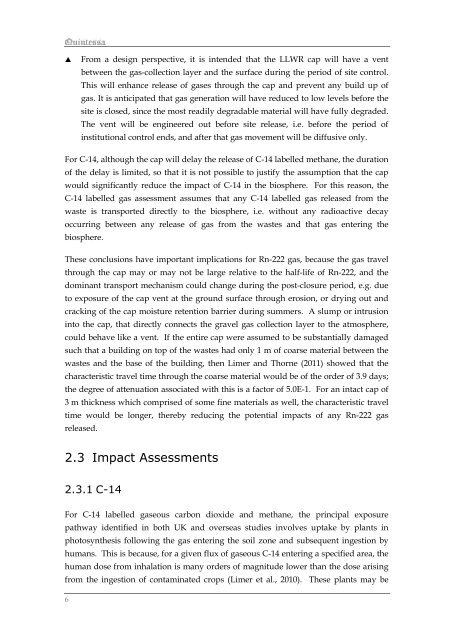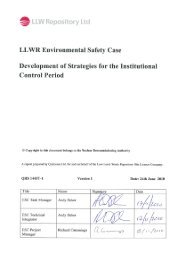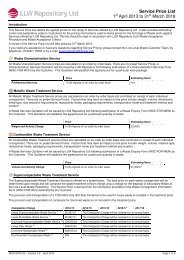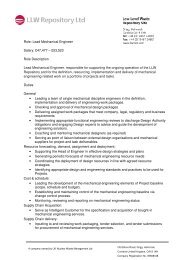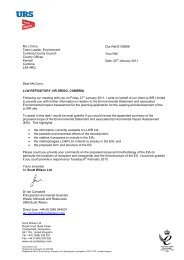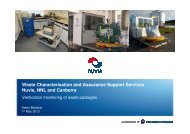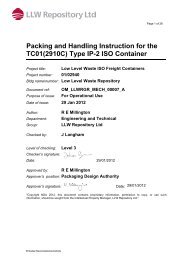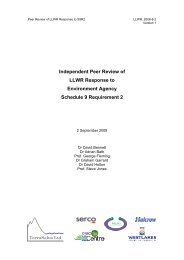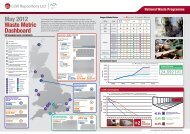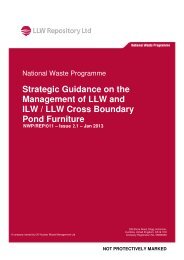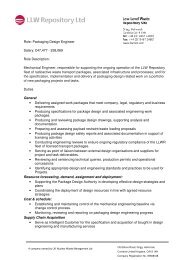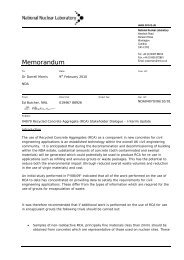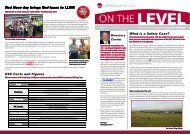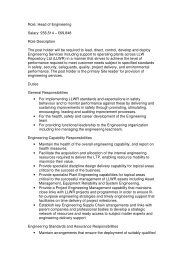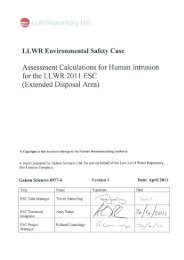Limer LMC, Assessment Calculations for C-14 Labelled Gas and ...
Limer LMC, Assessment Calculations for C-14 Labelled Gas and ...
Limer LMC, Assessment Calculations for C-14 Labelled Gas and ...
You also want an ePaper? Increase the reach of your titles
YUMPU automatically turns print PDFs into web optimized ePapers that Google loves.
From a design perspective, it is intended that the LLWR cap will have a ventbetween the gas-collection layer <strong>and</strong> the surface during the period of site control.This will enhance release of gases through the cap <strong>and</strong> prevent any build up ofgas. It is anticipated that gas generation will have reduced to low levels be<strong>for</strong>e thesite is closed, since the most readily degradable material will have fully degraded.The vent will be engineered out be<strong>for</strong>e site release, i.e. be<strong>for</strong>e the period ofinstitutional control ends, <strong>and</strong> after that gas movement will be diffusive only.For C-<strong>14</strong>, although the cap will delay the release of C-<strong>14</strong> labelled methane, the durationof the delay is limited, so that it is not possible to justify the assumption that the capwould significantly reduce the impact of C-<strong>14</strong> in the biosphere. For this reason, theC-<strong>14</strong> labelled gas assessment assumes that any C-<strong>14</strong> labelled gas released from thewaste is transported directly to the biosphere, i.e. without any radioactive decayoccurring between any release of gas from the wastes <strong>and</strong> that gas entering thebiosphere.These conclusions have important implications <strong>for</strong> Rn-222 gas, because the gas travelthrough the cap may or may not be large relative to the half-life of Rn-222, <strong>and</strong> thedominant transport mechanism could change during the post-closure period, e.g. dueto exposure of the cap vent at the ground surface through erosion, or drying out <strong>and</strong>cracking of the cap moisture retention barrier during summers. A slump or intrusioninto the cap, that directly connects the gravel gas collection layer to the atmosphere,could behave like a vent. If the entire cap were assumed to be substantially damagedsuch that a building on top of the wastes had only 1 m of coarse material between thewastes <strong>and</strong> the base of the building, then <strong>Limer</strong> <strong>and</strong> Thorne (2011) showed that thecharacteristic travel time through the coarse material would be of the order of 3.9 days;the degree of attenuation associated with this is a factor of 5.0E-1. For an intact cap of3 m thickness which comprised of some fine materials as well, the characteristic traveltime would be longer, thereby reducing the potential impacts of any Rn-222 gasreleased.2.3 Impact <strong>Assessment</strong>s2.3.1 C-<strong>14</strong>For C-<strong>14</strong> labelled gaseous carbon dioxide <strong>and</strong> methane, the principal exposurepathway identified in both UK <strong>and</strong> overseas studies involves uptake by plants inphotosynthesis following the gas entering the soil zone <strong>and</strong> subsequent ingestion byhumans. This is because, <strong>for</strong> a given flux of gaseous C-<strong>14</strong> entering a specified area, thehuman dose from inhalation is many orders of magnitude lower than the dose arisingfrom the ingestion of contaminated crops (<strong>Limer</strong> et al., 2010). These plants may be6


